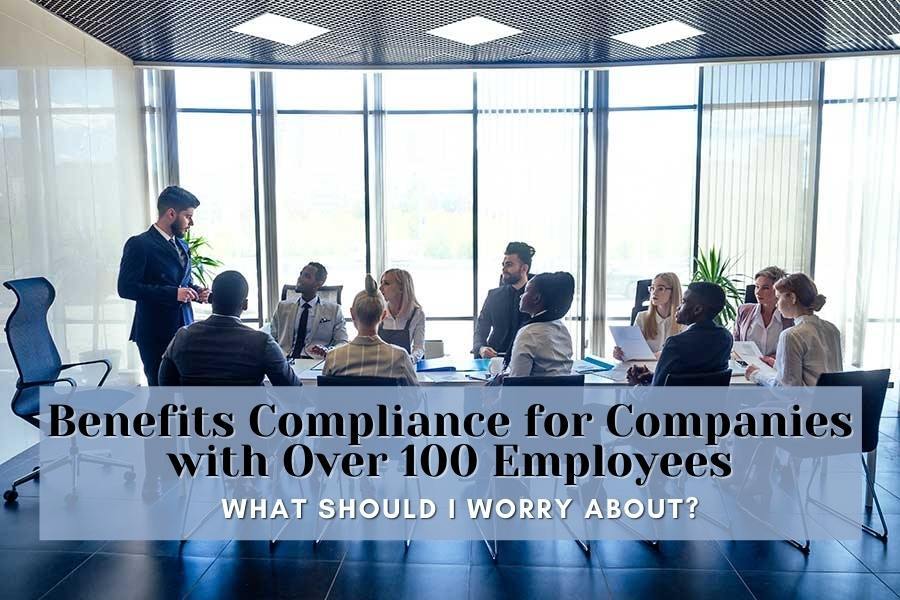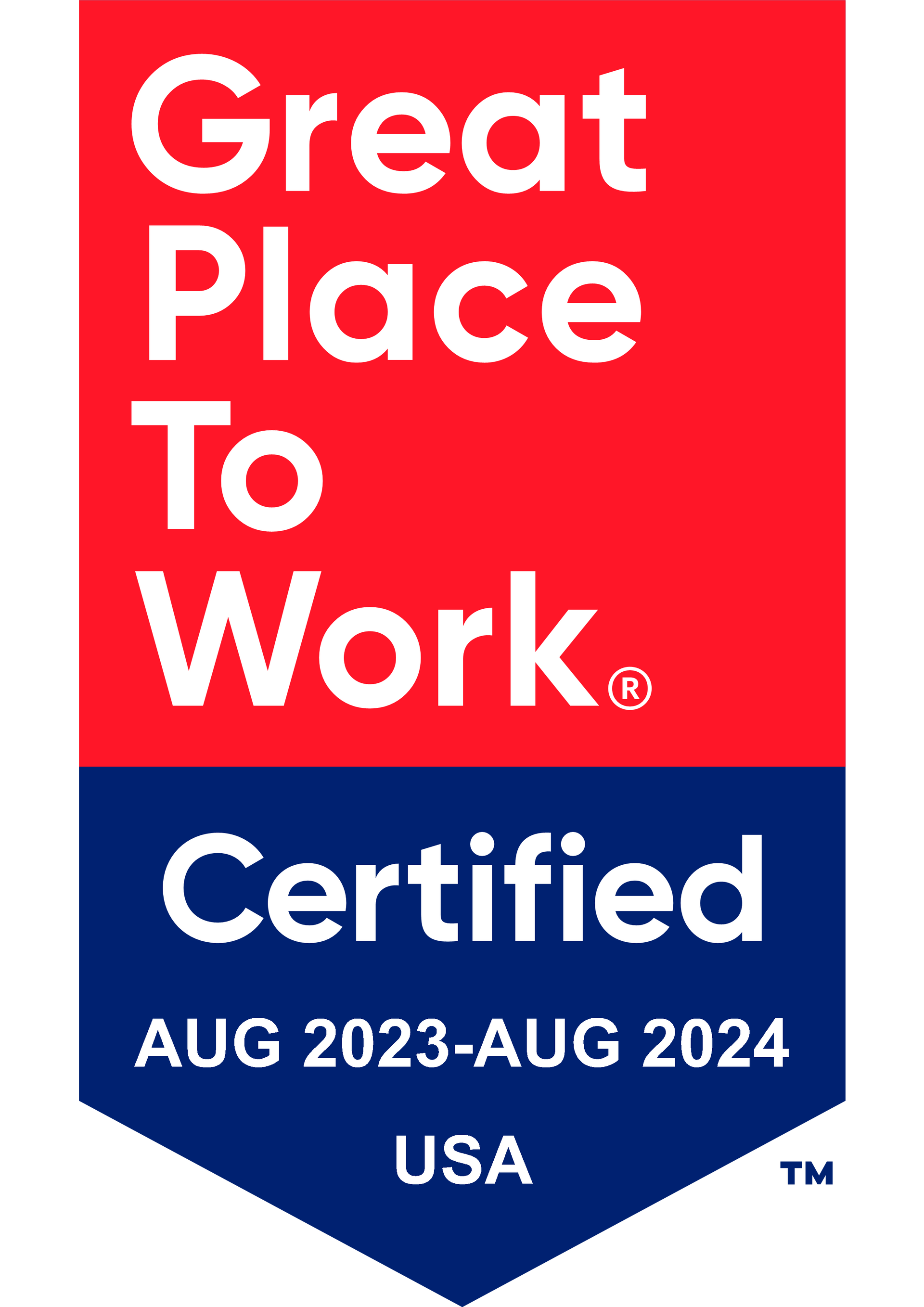Get in touch
408-366-8880
mymail@mailservice.com

Benefits Compliance for 100+ Employees: Here's What to Do
As you and your team celebrate your company’s growth, allowing you to cross the threshold of employing over 100 employees to become classified as a medium-sized business, everyone is likely brimming with excitement and ideas about how to keep up the momentum.
It’s natural to take pleasure in your hard work, success, and the ability to bring in new talent, but it also brings new responsibilities for your executive and HR teams to ensure benefits compliance. It’s imperative that as your business enters a new size bracket, you’ll need to get up to speed on some key insurance, benefits, and compliance matters, and you’ll need to adjust to ensure compliance and avoid breaching any regulations.
There’s nothing to worry about as long as you ensure compliance, but let’s take a look at some matters to get ahead of now to keep enjoying your success.
HR COMPLIANCE AT ANY LEVEL
Before advancing to the next level as an employer, it’s important to take a moment to review the basics of HR compliance. It’s a great way to take your cues in making any necessary adjustments when turning the corner to become a medium-sized business.
Establishing and maintaining optimal HR compliance involves identifying the need for and defining policies and procedures based on all applicable laws and regulations that establish healthy employment and work practices that benefit everyone in your organization.
Over the past few decades, there has been a sharp rise in the number of employment laws, policies, and regulations at all levels, posing the risk of incurring unprecedentedly steep fines and penalties for non-compliance. No one can afford to take such costly and unavoidable risks, especially when in the midst of a growth phase. It’s a lot to manage, getting up to speed on all the laws and regulations, but you’ll find it’s worth it and, more importantly, not optional without negative repercussions.
There are some HR policy and procedure constants for HR and legal departments to know and follow carefully to support any business moving up to the next level as an employer, such as:
- Determining whether the business is
subject to an HR audit from relevant enforcing agencies, especially one capable of and likely to levy fines and penalties for non-compliance
- Lack of knowledge or understanding about the next level of compliance obligations is not an acceptable legal defense for non-compliance
- Learning and recognizing all employment laws that must be followed, such as those that apply to local, state, and federal regulations.
Essentially, there is no “pause” button that will let your HR team catch up to compliance obligations at the next level. So, as you anticipate crossing over the threshold to become a medium-sized business, ensure that you have everything in perspective and do the following:
- Focus on proactive compliance with all applicable employment regulations, no matter your size, especially as your company is growing. As soon as you anticipate hiring over 100 employees, start researching laws and regulations at the next level.
- Ensure that your HR and legal departments stay current on the ever-and-rapidly changing regulatory landscape since private and government agency audits can happen at any time and scope.
THE BASICS OF HR COMPLIANCE TO REFRESH EFFECTIVELY AS YOU MOVE UP IN BUSINESS SIZE
As your business joins the ranks of medium-sized organizations across America, it’s time to review and rev up your approach to HR compliance. Many startups and other young, up-and-coming organizations probably do a fair amount of checklist-building to ensure compliance to avoid fines and penalties and stay afloat to maintain momentum.
However, as your business grows, you can afford to invest more in your HR department’s approach to compliance by always keeping the following considerations in mind:
- Discrimination
- Wages and Working Hours
- Immigration
- Employee Leave
- Benefits Administration
- Safety
- Union Rights
All the considerations in this list are critical, but keeping your benefits administration on course is as important in terms of compliance as it is for employee satisfaction and retention.
WHY IS IT SO IMPORTANT TO LET YOUR EMPLOYEES ABOUT THE BENEFITS CHANGES ASSOCIATED WITH LEVELING UP?
Your employees are a crucial part of your organization on a daily performative and productive level. What’s more, they’re also a critical part of your organization’s future, so keeping them abreast of everything going on is natural and good for morale, letting employees know you value them, whether they have worked with you for years or just signed on.
WHAT ARE YOUR PRIMARY BENEFITS CONCERNS AS A MEDIUM-SIZED BUSINESS?
One of the most important things you’ll learn when crossing over to become a medium-sized business is that much of your benefits compliance looks a lot like those applied to large corporations. So, you’ve made a bit of a quantum leap of sorts. In a way, that makes things easier in the long run, especially if you have your sights set on taking things to the 1,000+ employee level at some point.
Let’s take a closer look at some changes for acts, laws, and regulations that go into effect for medium-sized and large corporations.
THE AFFORDABLE CARE ACT
Passed and enacted during the Obama Presidential administration, the Affordable Care Act (ACA) is the name of the comprehensive health care reform law and all of its following amendments, notes the Department of Health and Human Services (HHS). There are two parts to the law, including the original enactment and a follow-up amendment one week later:
- The Patient Protection and Affordable Care Act was passed and signed into law on March 23, 2010.
- The Health Care and Education Reconciliation Act was passed on March 30, 2010, serving as an amendment to the first part.
The ACA focuses on ensuring a broader availability of health insurance coverage by assisting with healthcare costs and encouraging preventive care.
While small businesses must comply with some parts of the ACA, outlining health insurance requirements for employers, medium-sized businesses need to comply with all regulations in the Act, including all reporting requirements and any associated penalties.
The ACA limits out-of-pocket maximums for policyholders and waiting periods between someone’s hire data and their eligibility date to receive benefits. It also provides relief by excluding preexisting condition limitations and much more.
THE EMPLOYMENT RETIREMENT INCOME SECURITY ACT
The Employment Retirement Income Security Act of 1974 (ERISA) was enacted to protect the retirement assets of US workers. ERISA implemented rules that qualified plans must follow to ensure plan fiduciaries, entrusted to protect the insured parties’ interests, do not misuse the qualified plan’s assets. The plan lays out an expansive list of compliance obligations for all employers who sponsor or administer employee benefits plans, including:
- Mandatory disclosures
- Reporting requirements
- Sets minimum standards for participation in matters including vesting, benefit accrual, and retirement plan funding
THE FAMILY AND MEDICAL LEAVE ACT
The Family and Medical Leave Act (FMLA) kicks in long before companies hit medium-sized status since employers with 50 or more employees must comply with it. According to the US Department of Labor (DOL), the Act provides employees with up to 12 weeks of job-protected, unpaid leave each year. Further, FMLA ensures that an employee on leave maintains their group health benefits during their leave time.
Whether employees take leave to care for aging parents or for maternity or paternity leave for a newborn or newly adopted child, they can take the time they need, understanding they can return to their job without issue at the completion of their leave time.
THE CONSOLIDATED OMNIBUS BUDGET RECONCILIATION ACT
The Consolidated Omnibus Budget Reconciliation Act (COBRA) offers workers and their families a health insurance reprieve if they have lost their standard benefits. Employees might need COBRA under the following circumstances:
- Voluntary or involuntary job loss
- Reduction in hours worked
- Transition from one job to the next
- Death, divorce, or any other life-changing events that directly affect the employee’s immediate life and circumstances
- The qualifications for COBRA include paying the entire premium for coverage up to 102% of the cost of the plan for the employer.
THE GENETIC INFORMATION NON-DISCLOSURE ACT
The Genetic Information Non-Disclosure Act of 2008 (GINA) prohibits the practice of discrimination for employment and insurance coverage based on any genetic information known or discovered about the job candidate or employee.
ADDITIONAL LAWS AND REGULATIONS TO CONSIDER FOR YOUR MEDIUM-SIZED BUSINESS COMPLIANCE
Additional acts and laws that aren't as widely known but are just as important for medium-and-large-sized businesses include the Women’s Health and Cancer Rights Act (WHCRA) and the Newborns’ and Mothers’ Health Protection Act (NMHPA), and other acts and regulations.
It's also vital for your HR and legal teams to ensure that your organization complies with all state and local labor and benefits laws to ensure your organization remains compliant at all levels.
LEARN MORE ABOUT YOUR BENEFITS COMPLIANCE OBLIGATIONS AS A MEDIUM-SIZED BUSINESS
Even with this list of new, enhanced, upgraded, or overhauled benefits compliance obligations, you might need more help in navigating this exciting growth phase and transition. Our KBI Benefits team can help you and your HR team move up to the next level with ease, confidence, and complete compliance.
To learn more about how we can help, submit your information through our online contact form or call us at 408-366-8880. We look forward to assisting you during this exciting time and beyond!
Additional Resources:
- https://www.quicksprout.com/hr-compliance/
- https://blog.kbibenefits.com/hr-audits-101
- https://www.hhs.gov/answers/affordable-care-act/what-is-the-affordable-care-act/index.html
- https://blog.kbibenefits.com/blog/2019/7/3/tips-for-preparing-form-5500
- https://www.investopedia.com/terms/e/erisa.asp
- https://www.dol.gov/general/topic/benefits-leave/fmla
- https://blog.kbibenefits.com/benefits-of-paid-parental-leave
- https://www.dol.gov/general/topic/health-plans/cobra
Services
Latest Thinking




